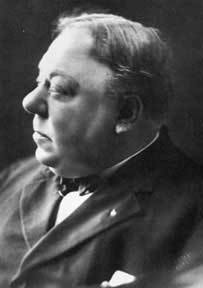- John Bunny
infobox actor

caption=
birthdate=birth date|1863|9|21
birthplace=city-state|New York City|New York
deathdate=death date and age|1915|4|26|1863|9|21
deathplace=city-state|Brooklyn|New York
occupation=Film , stageactor John Bunny (born
September 21 ,1863 in New York City,United States ; diedApril 26 ,1915 inBrooklyn, New York ), was the first comic star of the early Americansilent film era.John Bunny attended High School in Brooklyn and worked as a grocery clerk before joining a small
minstrel show touring the East Coast. He went on to jobs as stage manager for various stock companies and performed invaudeville before being drawn to the fledgling motion picture business. By 1910, Bunny was working atVitagraph Studios where the happy-go-lucky, rotund man quickly became an international star of silent film comedies. At Vitagraph he starred in a series of over 100 wildly popular comedies with the comedianFlora Finch that were popularly calledBunnyfinch es.The popularity of John Bunny can be attributed to the succulent fun of the music hall and the circus, not the dry wit of sophisticated comedies. He was jolly, boisterous, and broad in his acting, and because of this style, he connected strongly with early nickelodeon audiences. In a 1913 interview in Motion Picture Acting by Francis Agnew, he prophetically mused, “I believe the time is coming when motion picture machines will be a part of the equipment of every school and college in the country, and many branches of learning now so objectionable to children will be made interesting by the use of motion pictures. My principal worry is the fact that I can’t hope to live long enough to do all the work that I’ve mapped out for myself. I have planned fifty years of activity in the motion picture business, which I fear I will not live to carry out entirely. I want to see Latin and Greek mythology taught in every school and college in the United States by the use of films. It can and will be done and will be one of the biggest gifts to mankind the world has ever known.”
Regarding the motion picture industry as a profession, Bunny reflected to Francis Agnew, “There’s nothing like it. No other work gives an actor or would-be actor the same advantages. In the pictures, a player gets fifty-two weeks in the year. Where is the theatrical manager who can offer that? Not even vaudeville stars can get such bookings. At best, thirty weeks is about all an actor can expect on the stage. He may get summer stock work, but even so it is of uncertain duration. Stage work is a gamble. Even when you have been engaged for a production, rehearsed from three to six weeks without pay, and no doubt bought your own costumes for the piece, you have no guarantee that it will be a success. If the public does not set its stamp of approval, your job is all over perhaps after but one performance, and you can only repeat the procedure by trying again with someone else, charging the other to your loss account, with a credit notation probably on the page marked ‘experience.’”
John Bunny had only been acting in films for five years when he died from
Bright's disease and was interred in theCemetery of the Evergreens inBrooklyn, New York . Because silent film had no language barrier, Bunny's popularity was such that his death was front-page news inEurope as well as the United States.Following his passing, advances in technology and in stunts brought great new comedic stars to silent film that relegated John Bunny to the status of an almost completely-forgotten actor. However, John Bunny was eventually honored for his contribution to the motion picture industry with a star on the
Hollywood Walk of Fame at 1715 Vine Street inHollywood .In the "
The Art of the Moving Picture " (1915), American poet and early film criticVachel Lindsay considered Bunny to be the greatest of the early screen comedians.References
*"" by David W. Menefee.
*Agnew, Frances. Motion Picture Acting. New York: Reliance Newspaper Syndicate, 1913.
*Hayes, Helen. On Reflection. New York: M. Evans and Company, Inc., 1968.
*Pratt, George C. Spellbound in the Darkness. New York: New York Graphic Society Ltd., 1966.
*Ramsaye, Terry. A Million and One Nights. New York: Simon and Schuster, 1926.
*Slide, Anthony. “John Bunny.” The Silent Picture. New York: Arno Press, 1977.
*Smith, Albert E. Two Reels and a Crank. New York: Doubleday & Company, Inc., 1952.
*Talmadge, Margaret L. The Talmadge Sisters. Philadelphia and London: J. B. Lippincott Company, 1924.
*Talmadge, Norma. “Close-Ups.” Saturday Evening Post, March 12, 1926.
*Variety. The John Bunny Show. March, 19, 1915.External links
*imdb name|id=0120544|name=John Bunny
*amg name|2:187947
Wikimedia Foundation. 2010.
